One of The Best Non-Stealth Fighters in the World: Saab JAS 39 Gripen
The JAS 39 Saab Gripen, produced by Sweden, is one of the best non-stealth fighters in the world, and punches above its weight in terms of capabilities and costs.
Designed to balance capability and efficiency to face an enemy with superior numbers and competitive technology, the Saab Gripen The Saab JAS 39 Gripen is a Swedish light single-engine multirole fighter aircraft that has gained recognition as one of the most capable and cost-effective non-stealth fighters in the world.
Table of Contents
Overview
Historical Development
Specifications
Concept of Operations
Systems Engineering Requirements
Key Capabilities
Conclusion
References
Overview
The Saab JAS 39 Gripen is a Swedish light single-engine multirole fighter aircraft that has gained recognition as one of the most capable and cost-effective non-stealth fighters in the world. Designed to replace the Saab 35 Draken and 37 Viggen in the Swedish Air Force, the Gripen has evolved into a formidable combat aircraft that punches well above its weight class. Its exceptional versatility, advanced technology, and remarkable cost-effectiveness make it an attractive option for air forces seeking to maximize their defense capabilities within budget constraints.
At the heart of the Gripen's success is its advanced design and technology. The aircraft features a delta wing and canard configuration with relaxed stability design and fly-by-wire flight controls, allowing for superior maneuverability and agility. Powered by a single Volvo RM12 turbofan engine, the Gripen can reach speeds of Mach 2+ and operate at altitudes up to 50,000 feet. Its state-of-the-art avionics suite, including AESA radar, provides superior situational awareness, enabling it to detect, track, and engage multiple targets at greater distances and with higher precision than many of its contemporaries.
The Gripen's combat capabilities are equally impressive. Equipped with a wide array of weapons including beyond-visual-range missiles like the Meteor, the aircraft can effectively engage multiple targets at greater distances with high precision. Its multi-role capability allows it to excel in air-to-air combat, ground attack, and reconnaissance missions, making it a versatile asset for any air force. The Gripen's ability to operate from short, unprepared runways and its adaptability to various climatic conditions further enhance its operational flexibility. These features, combined with its cost-effectiveness, make the Saab JAS 39 Gripen a strong contender for being one of the best non-stealth fighters available in the world today.
Historical Development
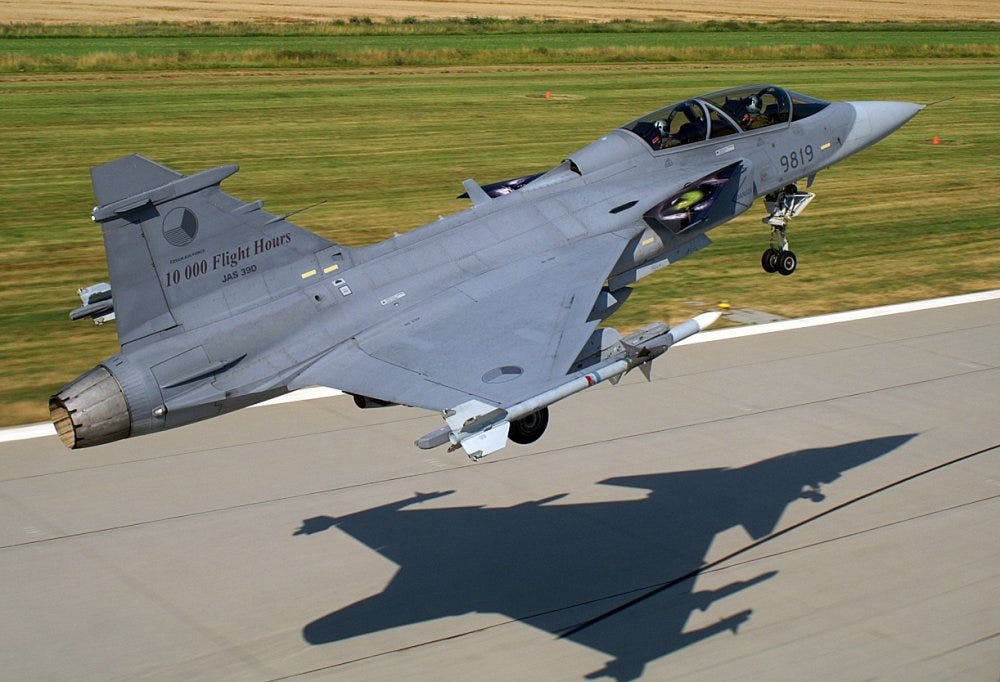
The Saab JAS 39 Gripen's development began in 1979 when Sweden initiated studies for a multirole aircraft to replace the Saab 35 Draken and 37 Viggen. The Gripen was conceived as a flexible, cost-effective fighter capable of performing fighter, attack, and reconnaissance roles in a single sortie, as reflected in its JAS designation (Jakt, Attack, Spaning - Swedish for Fighter, Attack, Reconnaissance).
This design approach was a response to evolving military requirements and economic constraints. Sweden needed an aircraft that could surpass its predecessors' capabilities while being more economical to produce, acquire, and maintain, especially considering the high costs of the Viggen program.
Further complicating the challenge of developing the Gripen was the legacy of the Draken and Viggen. The Draken and Viggen were legendary fighters in their own right, with the Saab 35 Draken being the FIRST Western European-built combat aircraft with true supersonic capability, first fully supersonic aircraft deployed in Western Europe, and the FIRST aircraft to perform the famous “Cobra” Maneuver.
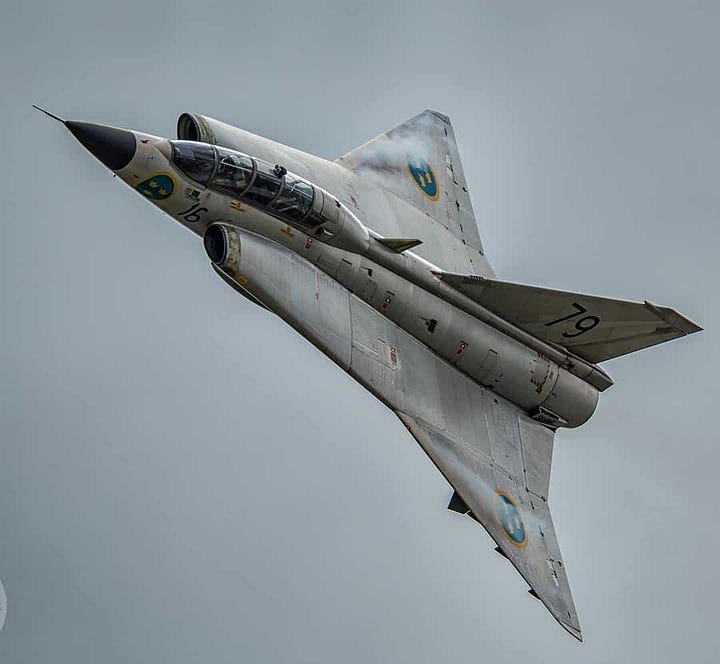
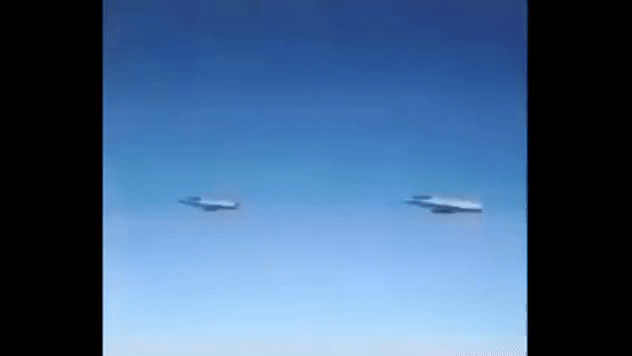
And the Viggen was the first aircraft that ever successfully intercepted the SR-71 per Aviation Geek Club:
[T]he first successful intercept of an SR-71 over the Baltic was carried out by Per-Olof Eldh, who recalls the incident: “In the 1980, I joined the 2nd Squadron “Blue Marlins” of Fighter Wing 13, equipped with the JA-37 fighter Viggen and based at Bravalla, just outside the town of Norrkšping, on the Baltic coast.
When i conducted the first Swedish Air Force intercept of an SR-71, the target had completed its north-bound pass of the Soviet coastline, and had turned west, south of the Finnish island of Aland, and was tracking south of a heading that would take it between Gotland and Öland. The datalink from the fighter controller was on, and I lined up for a head-on attack with a target angle of 180°. From my altitude of 8.000m I accelerated to Mach 1.35 then pulled up, very gently, continuing to accelerate to between Mach 1.7 and Mach 2.0, topping out at between 18.500 and 20.000m. All the target data was on my map display, including radar detection of the target at maximum range, which then locked on immediately afterwards. I simulated missile launches – the closing velocity was very high, between Mach 4.5 and 5.0; the SR-71 was flying at Mach 2.98 and 21.500m.
I had visual contact.
In total I have five hot intercepts against the SR-71 to my credit. All can be described as successful. I was visual three times; on a couple of occasions the SR-71 was contrailing, which was very useful because you could do a visual check to ensure you ended up in the right spot!
These two capable fighters were what the JAS 39 Gripen would need to replace at a lower cost in terms of acquisition, logistics, and maintenance, while increasing capability across the board. To achieve these goals, Saab led a joint venture of several Swedish defense equipment manufacturers, officially beginning work on the project in 1983. The aircraft was designed with advanced, highly adaptable avionics and a digital fly-by-wire system, allowing for improved maneuverability and reduced drag. These innovations, combined with a lighter single-engine design, contributed to the Gripen's cost-effectiveness, with operational costs estimated at $4,700 per flight hour in 2012, significantly lower than many of its competitors.
The Svenska Flygvapnet (Swedish Air Force) aims for the Gripen’s developement program were to produce an affordable Mach 2 aircraft with good short-field performance for a defensive dispersed basing plan in the event of invasion: BAS 60 in the early Cold War, and its successor, Bas 90 system. The Bas 90 system was based around defensive dispersal of aircraft across many krigsflygbaser (wartime air bases) in case of war, and dispersion of the air base functions within the individual bases themselves as a protective measure to make it complicated for an opponent to destroy the Swedish Air Force on the ground and thus ensure endurance for the air force in a conflict scenario e.g., airstrikes and nuclear weapons in the cold war.
Specifications
The Saab JAS 39 Gripen, particularly the latest E variant, boasts impressive technical specifications and capabilities:
Performance:
Maximum speed: Over Mach 2 (2,470 km/h) at high altitude
Supercruise capability: Over Mach 1 without afterburner
Service ceiling: 15,240 meters (50,000 feet)
Combat radius: 800 km
Ferry range: 3,200 km
Propulsion:
Engine: General Electric F414-GE-39E
Thrust: 22,031 lbf (98 kN) with afterburner
Dimensions:
Length: 15.20 meters (Gripen E)
Wingspan: 8.60 meters
Wing area: 25.5 m²
Avionics and Sensors:
AESA (Active Electronically Scanned Array) radar for superior situational awareness
Advanced electronic warfare suite with passive and active capabilities
Ability to detect, identify, and geolocate threats autonomously
Armament:
10 hardpoints for weapons and external fuel tanks
Internal Mauser BK-27 27mm single-barrel revolver cannon
Capability to carry up to seven Meteor Beyond Visual Range Air-to-Air Missiles and two IRIS-T Within Visual Range missiles simultaneously
Special Features:
STOL (Short Take-Off and Landing) capability: Can operate from 500m long, 16m wide road strips
Canard design for increased maneuverability and lift at slower speeds
Minimal turnaround time: Refueling and rearming in less than 10 minutes
Designed for dispersed basing and operation from makeshift runways
Enhanced navigation capability independent of GPS
These specifications make the Gripen E a highly versatile, agile, and technologically advanced fighter jet, capable of performing air-to-air, air-to-surface, and reconnaissance missions with exceptional effectiveness.
Concept of Operations
Based on the open-source information, this basic CONOPS outlines the operational framework, objectives, and procedures for utilizing the Gripen's swing-role capability to achieve optimal performance during various mission types.
Stakeholders:
Air Force commanders
Mission planners
Pilots
Ground crew and maintenance personnel
Defense procurement agencies
Saab engineers and technicians
Purpose: The primary purpose of the Gripen's swing-role capability is to provide a flexible and cost-effective solution for air forces, enabling a single aircraft to perform multiple mission types without the need for reconfiguration or returning to base.
Operational Overview:
Pre-Flight Operations:
Mission Planning: Detailed flight plans are developed, considering potential mission changes, threat assessments, and operational objectives.
Aircraft Configuration: The Gripen is equipped with a mix of weapons and sensors suitable for multiple mission types.
System Checks: Comprehensive checks are conducted to ensure the readiness of all systems, including avionics and weapons.
Flight Operations:
Takeoff: The Gripen can operate from short runways or even roads, enhancing operational flexibility.
Multi-Mission Capability: During flight, the pilot can switch between air-to-air, air-to-surface, and reconnaissance roles at the press of a button.
Real-time Adaptation: The aircraft's advanced avionics allow for rapid threat assessment and mission reprioritization mid-flight.
Post-Flight Operations:
Data Analysis: Mission data is analyzed to assess performance and identify areas for improvement.
Rapid Turnaround: The Gripen can be refueled and rearmed in less than 10 minutes, allowing for quick redeployment.
Key Capabilities:
Seamless transition between multiple roles during a single sortie
Advanced AESA radar for superior situational awareness
Ability to carry a wide range of weapons for various mission types
Short takeoff and landing capability for dispersed operations
NATO interoperability for joint operations
Summary: The JAS 39 Gripen's swing-role capability allows it to adapt to changing mission requirements in real-time. This versatility enables air forces to respond quickly to evolving threats and operational needs, maximizing the effectiveness of each sortie while minimizing the number of aircraft required for diverse mission sets.
Systems Engineering:
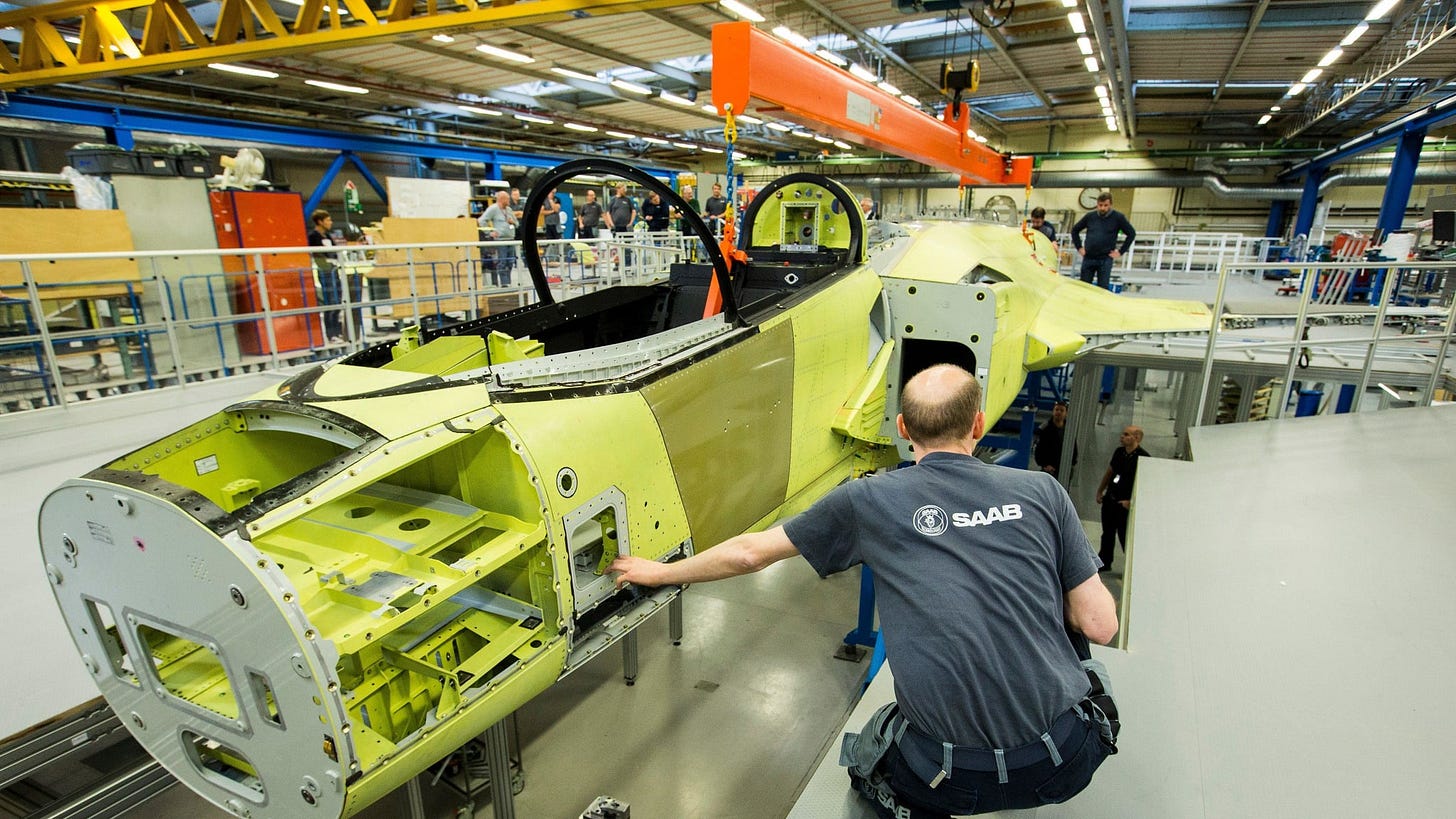
Points of Consideration in Systems Engineering Requirements:
Some keys to consider when performing systems engineering are to take into account:
The objectives of the system: What will the system need to accomplish?
Operating conditions: What kind of operating conditions will the system encounter?
The expected opposition: What kind of systems will it face?
With these considerations in mind, we can look into the high-level systems requirements of the Saab Gripen, and the likely reasoning for these requirements:
Objectives of the system:
The objectives the system will need to meet are:
Multiple roles: The Swedish Airforce, by narrowing roles e.g., bomber, interceptor, air-superiority, to specific fighters, would encounter bottlenecks in their capabilities should a tactical strike or combat eliminate a majority of a specific fighter, leaving Sweden with a glaring opening in their defense capability.
Take off and Land on Swedish Roads:
Minimized Maintenance: The need to fit into a dispersed Airbase system like Bas 90 to complicate threat planning from the Soviet Union and ensure Swedish Air Force endurance during a conflict meant that the aircraft would by necessity have to be placed away from large repair facilities which would be targeted.
Simple Maintenance: The limited number of aircraft afforded to the Swedish Air Force means that every second on the ground in maintenance means that there is one less aircraft in the air defending the country.
Requirements for Objectives
(Caveat: Systems Engineering requirements are normally more specific in terms of numbers and details .e.g, measurable verifiable/testable. The specifics of these requirements are unfortunately as I have not spoken or reached out to Saab or Gripen’s stakeholders for details).
The System shall be a Swing-Role Aircraft.
Sub-Requirement: The System shall carry air-to-air missiles
Sub-Requirement: The System shall carry air-to-ground missiles
Sub-Requirement: The System shall carry air-launched-anti-ship missiles
Reasoning: The creation of an expansion in defense capability is the need to be minimized delay or in the roles an aircraft can take during missions. This means that in one mission an aircraft could potentially perform a bomber, intercept, and reconnaissance role in the same mission. This is different from a multi-role aircraft, which would need to land and switch its armaments to perform a different mission.
The system shall take off and land on Swedish Roads
Reasoning: The Saab Gripen needs to utilize Sweden’s roads and highways as take-off and landing strips. Due to the smaller size of Sweden, in the event that airbases are attacked and runways are damaged, the Gripen can remain operational and perform is mission.
The System shall require minimized maintenance.
Reasoning: The dispersed nature of Sweden’s air force maximizes the endurance capability of the Swedish air force during a conflict. However this necessitates placing the aircraft away from potential targets like repair facilities.
Sub Requirements: All maintenance equipment for the Gripen shall fit within a transportable shipping container
Reasoning: By storing the aircraft away from large repair facilities, all the equipment needed to maintain the Gripen would need to fit in a shipping container to be transported with the aircraft to its dispersed location.
The System shall require simplified maintenance.
Reasoning: The limited number of Gripen aircraft means that every Gripen on the ground in maintenance is one less Gripen in the air, defending the country. Simplifying the maintenance of the Gripen translates to faster downtimes and a quicker return to the air and battle.
Operating Conditions for the system:
The system is expected to operate in all kinds of weather, especially the weather conditions of the North Atlantic.
The system was expected to operate from shortened runways of 800 meters due to the nature of dispersed basing from the BAS 60 and BAS 90 System.
Requirements for Operating Conditions:
The System Shall operate from temperatures of X degress C to temperatures of X degrees C:
Sub-requirement: The Systems key sub-systems shall work from 1__(High Temperature) to -(low temperature)
Reasoning: Without proper tracking of the requirements for temperature extremes such as those in the northern Baltic, it would not be possible for a complex system such as the Gripen to run.
The System Shall take off from runways of a minimum length of 800 meters
The System Shall land on Runways of a minimum length of 800 meters
The System shall take off from runways of a minimum width of X meters.
The Opposition:
The types of aircraft that the Gripen would face off against were highly-maneuverable Soviet Union Aircraft such as the Sukhoi-27 and Sukhoi-35:
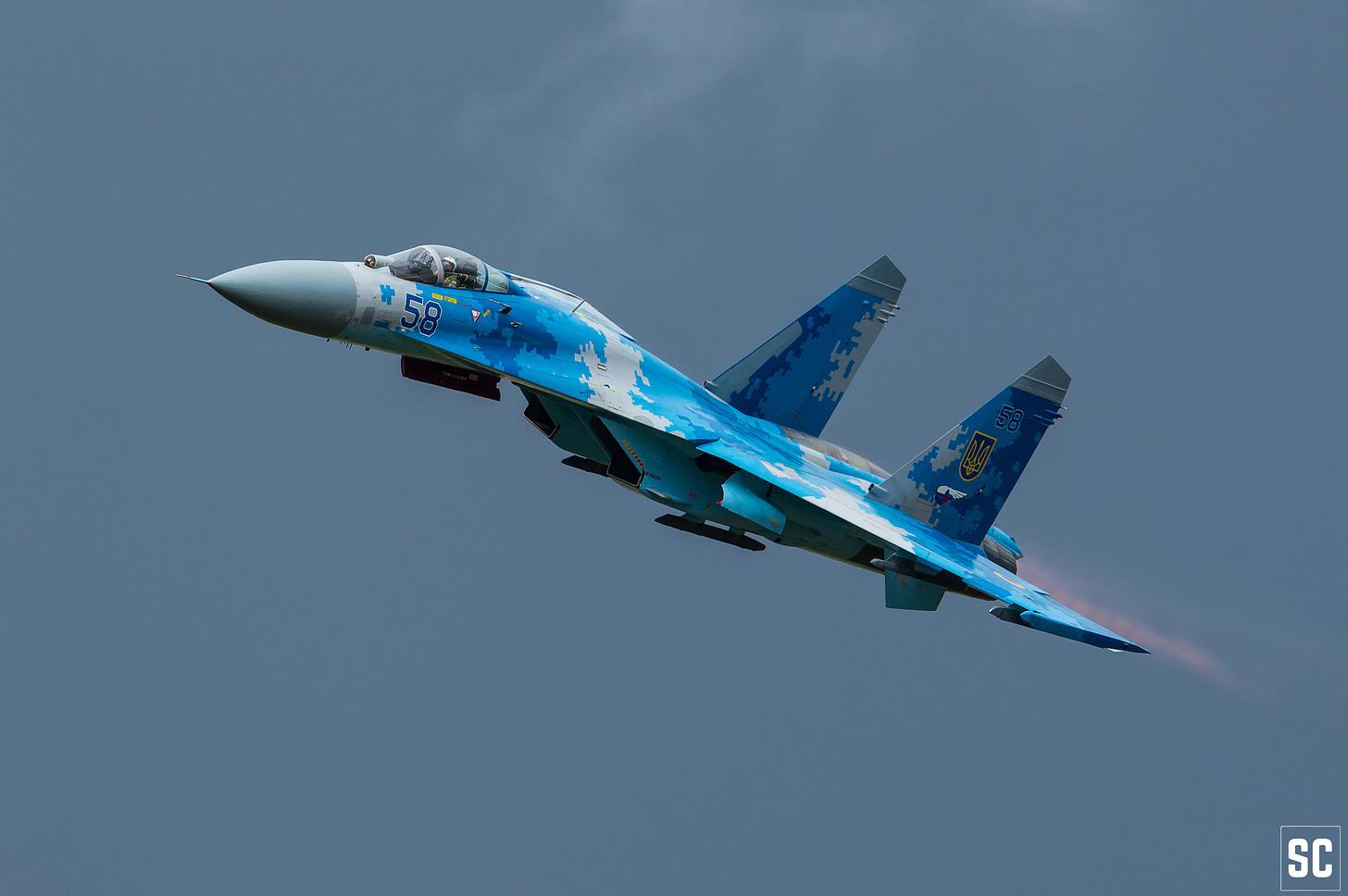

These types of fighters did not exist during the design-phase of the earlier Draken and Viggen, and would present a challenge to those Swedish fighters in an air superiority dogfight.
Requirements to address opposition:
The system shall perform beyond visual range engagements.
Rationale: The utilization of beyond visual range (BVR) engagements is to the Gripen’s advantage in this case, as engaging the Sukhoi’s outside of their high-maneuverability envelope favors engaging the Russian fighters from farther ranges.
The System Shall utilize advanced electronic warfare systems.
Rationale: To minimize the cost of developing the fighter, priority was given to maximizing the electronic warfare capabilities of the Gripen instead of focusing on radar signature reduction (stealth).
This utilization of advanced EW favors the Gripen in the BVR engagement range again as the maximizes the chance of the Gripen detecting, and then engaging Russian Fighters first.
The system shall utilize modular design for its subsystems and software.
Rationale: The utilization of modular design enables an aircraft to quickly update its defense and subsystem capabilities to the latest that are available on the market. The utilization of the “latest and greatest” systems allows for the maximization of defense capabilities for the Gripen, giving it defense capabilities on par with the F-35 at fractions of the cost.
The system shall utilize sensor fusion.
The implementation of modular software and the emergent capabilities from implementation enable the Gripen to utilize sensor fusion similar to the F-35 to enhance its situational awareness.
The system shall utilize information distribution.
Key Capabilities:
While the Gripen is considered a 4.5 generation aircraft primarily due the aircraft not utilizing RF signature reduction(“Stealth”), the aircraft’s utilization of avionics is comparable to that of the F-35 especially in Electronic Warfare, Sensor Fusion, and Dispersed Force Capability.
Electronic Warfare:
The Saab JAS 39 Gripen is equipped with one of the most advanced electronic warfare (EW) systems available in a modern fighter aircraft. Saab has placed a significant emphasis on enhancing the Gripen's electronic warfare capabilities, which is reflected in their strategic decision to focus on EW development rather than solely on stealth technologies. This approach not only helps to keep development costs down but also ensures that the Gripen remains competitive in a rapidly evolving battlefield environment.
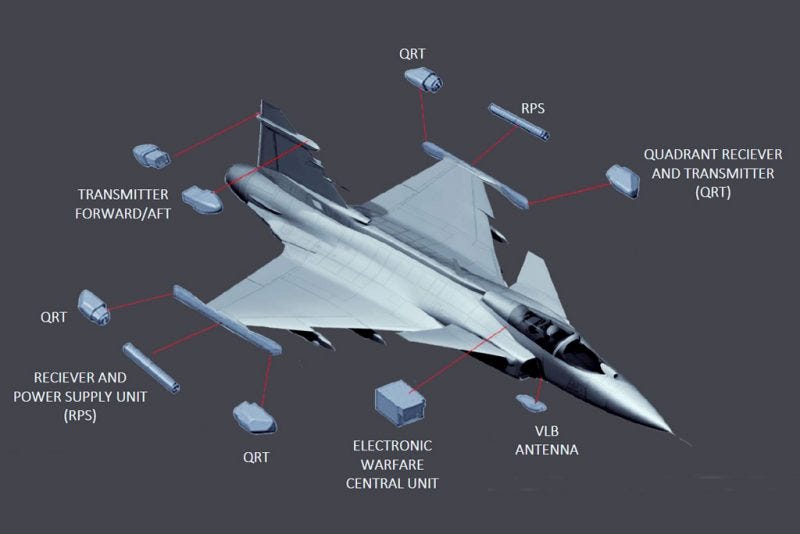
Advanced Components
The Gripen's EW system utilizes cutting-edge Gallium Nitride (GaN) components, which allow for a more compact and efficient design compared to older Gallium Arsenide (GaAs) systems. The use of GaN technology reduces the size of the EW system while enhancing its performance, making it comparable to the latest electronic warfare suites being developed for advanced platforms like the U.S. Navy's E/A-18 Growler and its Next Generation Jammer. . The effectiveness of the Gripen's EW capabilities is underscored by interest from Lockheed Martin, which as requested to buy two Saab Enhanced Survivability Technology (ESTL) pods, which include chaff, flare and decoy dispensing pods. —demonstrating the system's robustness and effectiveness in modern combat scenarios.
Comprehensive EW Suite
The Gripen's electronic warfare suite includes a variety of features designed for both offensive and defensive operations. Key elements include:
Missile Warning Systems (MAW): These systems provide early detection of incoming threats, allowing pilots to react swiftly to potential missile attacks.
Active Electronic Countermeasures (ECM): The Gripen can jam or deceive enemy radar systems, complicating targeting efforts against it. This capability is crucial for maintaining survivability in contested airspace.
Suppression of Enemy Air Defense (SEAD): The aircraft can target and neutralize enemy air defense systems, enhancing its operational effectiveness during missions.
The integration of these systems allows the Gripen not only to avoid detection but also to engage and attack adversaries effectively.
Sensor Fusion, Targeting, and Communication
The Gripen employs sophisticated sensor fusion techniques that integrate data from various onboard sensors, including its Infrared Search-and-Track (IRST) system, radar, and radio frequency (RF) receivers. This data is processed through advanced algorithms within the aircraft's flight computer to create a cohesive tactical picture for the pilot. This process involves several key steps:
Consolidated Track Files: The system establishes comprehensive track files that refine primary information from all sensors, providing a unified view of the operational environment.
Information Sharing: Track information from individual sensors is shared across the system, enhancing situational awareness by correlating data based on wavelength/frequency, field of regard, angular resolution, and distance.
Confidence Assessment: The system assesses the confidence level of consolidated tracks, suppressing redundant track symbols to declutter displays and presenting only the most relevant information to the pilot.
This method of sensor fusion mirrors capabilities found in advanced platforms like the F-35, which utilizes a Distributed Aperture System (DAS) AN/AAQ-37. for enhanced situational awareness. However, Saab's decision not to implement similar technology was likely driven by economic considerations and architectural constraints that would significantly alter the aircraft's design.
The Gripen's emphasis on electronic warfare capabilities over traditional stealth features positions it as a formidable contender in modern aerial combat from a different perspective compared to other aircraft. Its advanced EW systems not only enhance survivability but also enable proactive engagement against sophisticated threats. By focusing on sensor fusion and effective communication between onboard systems, the Gripen provides pilots with unparalleled situational awareness and operational flexibility in contested environments. This strategic approach allows the Gripen to maintain high levels of effectiveness while keeping operational costs manageable, ultimately ensuring its relevance in future air combat scenarios.
Dispersed Force Capability
I will pull directly from Saab’s website to describe the Dispersed Force Capabilities of the Gripen:
Sweden’s operational requirements for Gripen were driven by a superpower threat of all-out conflict across air, land, and sea. This simple statement hides the highest possible objective; national survival.
In times of tension, when threat levels are rising, a small Gripen unit can deploy away from its regular base to provide an agile quick reaction alert (QRA). This deployed force is automatically less vulnerable to surprise attack and can operate closer to expected areas of enemy activity.
The ability to disperse forces is crucial in a landscape where conventional air bases may be targeted by adversaries, thereby ensuring that Sweden's air defense capabilities remain intact.
The Dispersed Force Capability was integral to the Gripen's design, ensuring that the resulting aircraft would meet the needs of a country that may face off against a superpower in a conflict that would determine the nation's very survival. By allowing for operations from various locations, including small airstrips and even highways, the Gripen can effectively utilize Sweden's geography to its advantage. This flexibility not only enhances survivability but also complicates the targeting calculus for potential adversaries.
Operational Advantages
Agility in Deployment: The Gripen's ability to quickly relocate and establish operational readiness at different sites allows for rapid response to emerging threats. This agility is particularly important during heightened tensions or conflicts, where every minute counts.
Reduced Vulnerability: By deploying smaller units away from primary bases, the Gripen minimizes the risk of mass casualties from surprise attacks. This strategy ensures that even if one unit is compromised, others can continue to operate effectively.
Enhanced Situational Awareness: Deployed units can operate closer to expected areas of enemy activity, allowing them to gather intelligence and respond more effectively to threats. This proximity improves reaction times and enhances overall mission success rates.
Support for Coalition Operations: The Gripen's dispersed operations capability is not limited to national defense; it also supports coalition operations alongside NATO allies. Its ability to integrate seamlessly into joint missions enhances collective security efforts.
Historical Context: The design philosophy behind the Gripen is rooted in Sweden's Cold War strategies, particularly the Bas 90 system, which emphasized dispersed air operations to complicate enemy targeting efforts. This historical context informs current operational practices and underscores the importance of maintaining a robust air defense posture.
Logistical Efficiency: The Gripen requires minimal ground support equipment and personnel, which further enhances its operational flexibility. For instance, it can be rearmed and refueled in under ten minutes with just a few technicians, allowing for higher sortie rates during critical missions.
Interoperability with NATO: As part of its commitment to collective defense, the Gripen has proven its effectiveness in NATO missions, demonstrating its capability to operate alongside other allied forces while maintaining high readiness levels.
The Dispersed Force Capability of the Gripen is a fundamental aspect of its design and operational strategy. It not only ensures national survival in the face of potential superpower threats but also enhances Sweden's ability to contribute effectively to international security efforts alongside NATO allies. The combination of agility, reduced vulnerability, and logistical efficiency makes the Gripen a vital asset in modern aerial warfare scenarios.
Maintenance
The Saab JAS 39 Gripen is designed with a focus on minimized and simplified maintenance to address unique operating conditions and maximize operational effectiveness. This approach is crucial for several reasons:
Modular Design:
The Gripen's major systems, including the engine and radar, are designed for quick replacement and increased reliability. An engine change can be completed in less than an hour, even at a dispersed road airbase. This modular approach extends to other critical components as well.
For instance, complex avionics equipment can also be replaced within an hour. The design allows for easy access to maintenance areas, with push-button latches for quick opening and closing of access panels.
The engine can be removed from the airframe by disconnecting only a few bolts, fuel and hydraulic lines, and detaching the gearbox. This modular design significantly reduces downtime and enhances the aircraft's operational readiness.
Minimal Tools:
The support system is engineered to require few specialized tools, simplifying maintenance procedures and reducing logistical burden. A notable example is the versatile portable mini-hoist, which serves dual purposes - it's used for both loading external stores and changing engines.
This multi-functional tool exemplifies the Gripen's philosophy of minimizing equipment while maximizing utility. The engine can be lowered using hand-cranked winches, similar to fishing rod mechanisms, further demonstrating the simplicity and ingenuity of the maintenance system.
Simplified Procedures:
Maintenance actions for the Gripen are designed to be few and simple, extending the mean time between maintenance. This approach not only reduces the frequency of maintenance but also allows for rapid turnaround times.
An air-to-air mission preparation, including refueling and rearming, can be completed in less than ten minutes using only one technician and five conscript mechanics with minimal training.
This efficiency is crucial for maintaining high operational readiness, especially in scenarios where quick redeployment is necessary.
Reduced Logistic Footprint: The Gripen's support system is remarkably compact. Everything required by two Gripen fighters for a two-week mission can fit in a standard 20-foot container. This minimal logistic footprint makes the Gripen extremely suitable for deployed operations, allowing for rapid deployment and operation from various locations.
The compact nature of the support system also enhances the aircraft's survivability by enabling quick dispersal of equipment and personnel after maintenance operations.
Harsh Environment Operations: The Gripen is built to operate in extreme climates and from dispersed and unprepared road bases or airstrips. It can land or take off using a road strip 800x16 m rather than a typical runway 2,400x45 m. This capability has been thoroughly tested under various conditions.
The aircraft has no issues operating in extreme cold or hot weather conditions, with successful tests conducted in temperatures below -30 degrees Celsius. This adaptability makes the Gripen suitable for diverse operational environments, from Arctic conditions to hot desert climates.
Self-Sufficiency: The Gripen's auxiliary power unit enables self-sufficiency in terms of power, reducing dependence on ground equipment. This feature is particularly valuable in dispersed operations or at forward operating bases where access to ground power may be limited. The self-sufficiency in power generation contributes to the aircraft's ability to operate from austere locations with minimal support infrastructure.
These design features and operational capabilities make the Gripen highly effective in scenarios where rapid deployment, minimal logistical support, and operation in harsh or austere conditions are required. The aircraft's maintenance philosophy not only enhances its operational flexibility but also significantly reduces lifecycle costs and improves overall availability rates.
Conclusion:
The Saab JAS 39 Gripen represents a significant advancement in modern military aviation, combining versatility and cost-effectiveness. Designed to meet the evolving needs of the Swedish Air Force, the Gripen excels in various roles, including air-to-air combat and ground attack. Its advanced technology, such as the AESA radar and electronic warfare capabilities, enhances its operational effectiveness. This adaptability allows the Gripen to function effectively in diverse combat scenarios, making it a formidable asset for national defense.
The Gripen's historical development reflects Sweden's strategic response to potential superpower threats. By emphasizing dispersed operations and simplified maintenance, the aircraft is designed to maximize availability and endurance. This approach ensures that even when faced with overwhelming odds, the Swedish Air Force can maintain its operational capabilities. The Gripen's ability to operate from short runways and unprepared sites further enhances its survivability in a contested environment.
The Saab JAS 39 Gripen stands out as a highly capable multirole fighter that meets modern defense requirements. Its combination of advanced technology, operational flexibility, and cost-effectiveness positions it as one of the best non-stealth fighters available today. As global military dynamics continue to evolve, the Gripen will remain a vital component of Sweden's defense strategy and an important player in international air operations.
References:
Sweden's Gripen Fighter Has Become The World's Best Second-Tier Jet
For Sale! Russia Is Showing Off Its Su-35 Stealth Fighter | The National Interest
Saab Gripen The Smart Fighter | Best of Aviation Series (youtube.com)
The fearsome electronic warfare capabilities of the Saab Gripen E | Hush-Kit (hushkit.net)
F-35 Program Office Eyes Gripen’s EW Pod | Aviation Week Network
AN/AAQ-37 Electro-Optical Distributed Aperture System - Wikipedia








